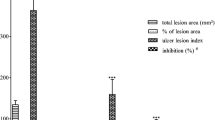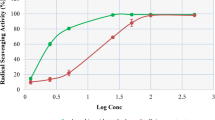Abstract
Ocimum sanctum Linn. (O. sanctum) is a plant used in the traditional systems of medicine for healing several ailments. In the present study, the antiulcer activity of 50, 100, and 200 mg/kg doses of the aqueous extract (AE) of O. sanctum leaves was evaluated using ethanol and aspirin-induced ulcer models. The role of nitric oxide (NO) in the antiulcer activity of O. sanctum was evaluated by administering Nω-nitro-L-arginine-methyl ester hydrochloride (L-NAME), a NO synthase inhibitor, to AE treated rats before inducing ulcers by ethanol. The myeloperoxidase (MPO) and malonylaldehyde (MDA) levels were measured in AE treated rats in the aspirin-induced ulcer model so as to evaluate the role of antioxidation in the antiulcer activity. AE showed a dose-dependent and significant (p < 0.05) decrease in the ulcer index (UI) and increase in the percentage protection (PP) compared to the control group, in both the animal models employed. L-NAME pretreatment did not cause any significant (p < 0.05) change in the antiulcer activity of AE. The levels of MPO and MDA were significantly (p < 0.05) reduced by 100 and 200 mg/kg doses of the AE suggesting an antioxidant mechanism in its antiulcer activity. The bioactive phytochemicals isolated from the leaves may be responsible for the gastroprotective action of O. sanctum. The results of the study confirm the ethnopharmacological claim of O. sanctum leaves being effective in the treatment of peptic ulcer disease.
Similar content being viewed by others
References
Adinortey MB, Ansah C, Galyuon I, Nyarko A (2013) In vivo models used for evaluation of potential antigastroduodenal ulcer agents. Ulcers 2013:1–12. doi:10.1155/2013/796405
Almeida ED, Filho VC, Neiro R, Clasen BK, Balogun SO, Martins DO (2011) Pharmacological mechanisms underlying the anti-ulcer activity of methanol extract and canthin-6-one of Simba ferruginea A St-Hil. In animal models. J Ethnopharmacol 134:630–36
Al-Tamemi SS, Al-Mashhedy LA (2015) Estimation of the phytochemical constituents and biological activity of Iraqi Ocimum sanctum L. extracts. Int J Pharma Bio Sci 6:999–1007
Balasubramanian S, Ganesh D, Reddy PS, Narayana VS (2014) GC-MS analysis of phytocomponents in the methanolic extract of Ocimum sanctum (Tulsi). Asian J Pharmaceutica Anal Med Chem 2:71–75
Borrelli F, Izzo AA (2000) The plant kingdom as a source of antiulcer remedies. Phytother Res 14:581–91
de Sousa Araujo TA, Alencar NL, de Amorim ELC, de Albuquerque UP (2008) A new approach to study medicinal plants with tannins and flavonoids contents from the local knowledge. J Ethnopharmacol 120:72–80
Deo SS, Inam F, Mahashabde RP (2011) Antimicrobialactivity and HPLC fingerprinting of crude Ocimum extracts. E-J Chem 8:1430–37
Devendran G, Balasubramanium U (2011) Qualitative phytochemical screening and GC-MS analysis of Ocimum sanctum L. leaves. Asian J Plant Sci Res 1:44–48
Dharmani P, Kuchibhotla VK, Maurya R, Srivastava S, Sharma S, Palit G (2004) Evaluation of antiulcerogenic and ulcer-healing properties of Ocimum sanctum Linn. J Ethnopharmacol 93:197–206
Fornai M, Natale G, Colucci R, Tuccori M, Carazzina G, Antonioli L, Baldi S, Lubrano V, Abramo A, Blandizzi C, Tacca MD (2005) Mechanisms of protection by pantoprazole against NSAID-induced gastric mucosal damage. Naunyn Schmiedeberg’s Arch Pharmacol 372:79–87
Ganguly AK, Bhatnagar OP (1973) Effect of bilateral adrenalectomy on the production of restraint ulcers in the stomach of albino rats. Can J Physiol Pharmacol 51:748–50
Gautam MK, Goel RK (2014) Toxicological study of Ocimum sanctum Linn leaves: Hematological, biochemical, and histological studies. J Toxicol 2014:1–9. doi:10.1155/2014/135654
Goel RK, Sairam K, Dorababu M, Prabha T, Rao CV (2005) Effect of standardized extract of Ocimum sanctum Linn. on gastric ulcer mucosal offensive and defensive factors. Indian J Exp Biol 43:715–21
Gupta SK, Prakash J, Srivastava S (2002) Validation of traditional claim of Tulsi, Ocimum sanctum Linn. as a medicinal plant. Indian J Exp Biol 40:765–73
Hollander D, Tarnawski A, Krause WJ, Gergely H (1985) Protective effect of sucralfate against alcohol-induced gastric mucosal injury in the rat. Macroscopic, histological, ultrastructural, and functional time sequence analysis. Gastroenterology 88:366–74
Joshi RK (2013) Chemical composition, in vitro antimicrobial and antioxidant activities of the essential oils of Ocimum gratissimum, O. sanctum and their major constituents. Indian J Pharm Sci 75:457–462
Kath R, Gupta R (2012) Comparison of the efficacy of Ocimum sanctum against gastric and duodenal ulcers in animals. The Internet J Gastroenterol 11:1–5
Konturek SJ, Brzozowski T, Majka J, Pytko-Polonczyk J, Stachura J (1993) Inhibition of nitric oxide delays healing of chronic gastric ulcers. Eur J Pharmacol 293:215–7
Krawisz JE, Sharon P, Stenson WF (1984) Quantitative assay for acute intestinal inflammation based on myeloperoxidase activity Assessment of inflammation in rats and hamster models. Gastroenterology 87:1344–50
Malfertheiner P, Chan FK, McColl KE (2009) Peptic ulcer disease. The Lancet 374:1449–61
Matsuda HY, Yoshikawa M (1999) Roles of capsaicin-sensitive sensory nerves endogenous nitric oxide, sulfhydryls and prostaglandins in gastroprotection by momordin Ic, an oleanolic acid oligoglycoside, on ethanol-induced gastric mucosal leasons in rats. Life Sci 65:27–32
McQuaid KR (2015) Drugs used in the treatment of gastrointestinal diseases. In: Katzung BG, Trevor AJ (eds) Basic and clinical pharmacology. McGraw-Hill, New York, pp 1536–79
Mondal S, Mirdha BR, Mahapatra SC (2009) The science behind sacredness of Tulsi (Ocimum sanctum Linn.). Indian J Physiol Pharmacol 53:291–306
Norr H, Wagner H (1992) New constituents from Ocimum sanctum. Planta Med 58:574
Ohkawa H, Ohsishi N, Yagi K (1979) Assay for lipid peroxidise in animal tissue by thiobarbituric acid reaction. Anal Biochem 95:351–58
Pandey G, Madhuri S (2010) Pharmacological activities of Ocimum sanctum (Tulsi): A review. Int J Pharm Sci Rev Res 5:61–66
Pattanayak P, Behera P, Das D, Panda SK (2010) Ocimum sanctum Linn. A reservoir plant for therapeutic applications: an overview. Pharmacogn Rev 4:95–105
Rahman S, Islam R, Kamruzzaman M, Alam K, Jamal AM (2011) Ocimum sanctum L.: A review of phytochemical and pharmacological profile. Am J Drug Discov Dev 2011:1–15. doi:10.3923/ajdd.2011
Shetty S, Udupa S, Udupa L (2008) Evaluation of antioxidant and wound healing effect of alcoholic and aqueous extract of Ocimum sanctum Linn. in rats. Evid Based Complement Altern Med 5:95–101
Singh S, Majumdar DK (1999) Evaluation of the gastric antiulcer activity of fixed oil of Ocimum sanctum. J Ethnopharmacol 65:13–9
Valle JD (2011) Peptic ulcer disease and related disorders. In: Longo DL, Fauci AS, Kasper DL, Hauser SL, Jameson JL, Loscalzo J (eds) Harrison’s principles of internal medicine. McGraw-Hill, New York, pp 2438–59
Vogel HG (2002) Drug discovery and evaluation, pharmacological assay. Springer, New York
Wallace JL, Sharkey KA (2012) Pharmacotherapy of gastric acidity, peptic ulcers, and gastroesophageal reflux disease. In: Brunton LL (ed) Goodman and Gilman’s the pharmacological basis of therapeutics. McGraw-Hill, New York, pp 1307–51
Williamson E, Okpako D, Evans F (1986) Pharmacological methods in phytotherapy research. Wiley and Son, Chinchester
Acknowledgments
The study was not supported by any source of funding. The authors are grateful to Dr. PK Ojha and Dr. HK Sharma from the Department of Pharmacology, Gauhati Medical College, Assam for providing essential inputs during the conduct of the study.
Author information
Authors and Affiliations
Corresponding author
Ethics declarations
Ethical Statement
The experimental protocol was approved by the Institutional Animal Ethics Committee and confirm to the ‘Guidelines for care and use of animals in scientific research’ (Indian National Science Academy 1998, Revised 2000).
Conflict of Interest
The authors declare that they have no conflict of interest.
Rights and permissions
About this article
Cite this article
Bhajoni, P.S., Meshram, G.G., Lahkar, M. et al. Evaluation of the role of nitric oxide and antioxidation in the antiulcer activity of Ocimum sanctum leaves: an experimental study. Orient Pharm Exp Med 15, 313–317 (2015). https://doi.org/10.1007/s13596-015-0197-3
Received:
Accepted:
Published:
Issue Date:
DOI: https://doi.org/10.1007/s13596-015-0197-3




